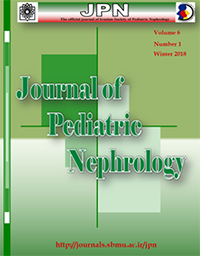Associated Factors of Primary Enuresis Among Children and Adolescents in Amhara Region, Northwest, Ethiopia, 2016
Journal of Pediatric Nephrology,
Vol. 6 No. 1 (2018),
4 May 2018
,
Page 1-8
https://doi.org/10.22037/jpn.v6i1.18903
Abstract
Introduction: Primary enuresis is the most common elimination disorder in children and adolescents aged 5-17 years worldwide. It often results in psychological, social, and financial problems. This disorder is understudied in less affluent countries.
Objective: This study was done to assess the prevalence and associated factors of primary enuresis in children and adolescents in Bahir-Dar Town, Ethiopia.
Materials and Methods: This cross-sectional community-based study was conducted in children and adolescents from May to July 2016. A total of 1547 subjects were selected using a multistage sampling technique. Data were collected using DSM-5 criteria and the Strengths and Difficulties Questionnaire (SDQ).
Results: A total of 1520 participants were involved in the study with a response rate of 98.25%. The prevalence of primary enuresis was 8.6%. Age range 5-8 years [AOR=10.35, 95% CI (3.468, 30.875)], deep sleep [AOR=2.18, 95% CI (1.192, 3.983)], and conduct problems [AOR=5.98, 95% CI (3.341, 10.694)] were significantly associated with primary enuresis.
Conclusions: Factors that affect primary enuresis are young age, deep sleep, snoring during sleep, sleeping more than two hours a day, and conduct problems. Therefore, special attention should be given to children and adolescents about primary enuresis prevention.
Keywords: Primary enuresis; Child; Adolescent- Primary enuresis
- child and adolescent
How to Cite
References
Alkot M, Deeb M. Nocturnal enuresis among school children in Menofia Governorate, Egypt; a hidden problem. J Am Sci. 2012;8(1):327-34.
Ozden C, Ozdal OL, Altinova S, Oguzulgen I, Urgancioglu G, Memis A. Prevalence and associated factors of enuresis in Turkish children. International Braz J Urol. 2007;33(2):216-22.
Al Matrafi HM. Enuresis improvement and its associated factors among children attending enuresis clinic at Rusaifah. International Journal of Medical Science and Public Health. 2015;4(1):109-16.
Salih K, Ahmed FE, Salih A, Elnour W, Hussien K, Omer Y. Characteristics and aetiological factors of nocturnal enuresis in Sudanese children. Health Educ. 2013;1(2):40-5.
Yeung CK, Sreedhar B, Sihoe JD, Sit FK, Lau J. Differences in characteristics of nocturnal enuresis between children and adolescents: a critical appraisal from a large epidemiological study. BJU International. 2006;97(5):1069-73.
Nappo S, Del Gado R, Chiozza M, Biraghi M, Ferrara P, Caione P. Nocturnal enuresis in the adolescent: a neglected problem. BJU International. 2002;90(9):912-7.
Desta M, Hägglöf B, Kebede D, Alem A. Socio‐demographic and psychopathologic correlates of enuresis in urban Ethiopian children. Acta Paediatrica. 2007;96(4):556-60.
Cendron M, Klauber G. Combination therapy in the treatment of persistent nocturnal enuresis. British Journal of Urology. 1998;81(s3):26-8.
Dundaroz R, Turkbay T, Erdem U, Congologlu A, Sakallioglu O, Tascilar E. Pupillometric assessment of autonomic nervous system in children with functional enuresis. International urology and nephrology. 2009;41(2):231-5.
Elbahnasawy HT, Elnagar MA. Psychological Impact of Nocturnal Enuresis on Self-esteem of School Children. American Journal of Nursing Research. 2015;3(1):14-20.
Van Tijen N, Messer A, Namdar Z. Perceived stress of nocturnal enuresis in childhood. British Journal of Urology. 1998;81(s3):98-9.
Mohammed AH, Saleh AG, Al Zoheiry I. Frequency of bedwetting among primary school children in Benha city, Egypt. Egyptian Journal of Medical Human Genetics. 2014;15(3):287-92.
Läckgren G, Lilja B, Neveus T, Stenberg A. Desmopressin in the treatment of severe nocturnal enuresis in adolescents—a 7‐year follow‐up study. British Journal of Urology. 1998;81(s3):17-23.
Von Gontard A, Mauer-Mucke K, Plück J, Berner W, Lehmkuhl G. Clinical behavioral problems in day-and night-wetting children. Pediatric Nephrology. 1999;13(8):662-7.
BOYBEYİ Ö, Aslan MK, DURMUŞ EG, ÖZMEN İ, Soyer T. A comparison of dysfunctional voiding scores between patients with nocturnal enuresis and healthy children. Turkish journal of medical sciences. 2014;44(6):1091-4.
Dolgun G, Savaser S, Balci S, Yazici S. Prevalence of nocturnal enuresis and related factors in children aged 5-13 in istanbul. Iranian journal of pediatrics. 2012;22(2):205.
Gunes A, Gunes G, Acik Y, Akilli A. The epidemiology and factors associated with nocturnal enuresis among boarding and daytime school children in southeast of Turkey: a cross sectional study. BMC Public Health. 2009;9(1):357.
Shreeram S, He J-P, Kalaydjian A, Brothers S, Merikangas KR. Prevalence of enuresis and its association with attention-deficit/hyperactivity disorder among US children: results from a nationally representative study. Journal of the American Academy of Child & Adolescent Psychiatry. 2009;48(1):35-41.
Swithinbank L, Brookes S, Shepherd A, Abrams P. The natural history of urinary symptoms during adolescence. British Journal of Urology. 1998;81(s3):90-3.
Chang P, Chen W, Tsai WY, Chiu YN. An epidemiological study of nocturnal enuresis in Taiwanese children. BJU International. 2001;87(7):678-81.
Joinson C, Sullivan S, von Gontard A, Heron J. Early childhood psychological factors and risk for bedwetting at school age in a UK cohort. European child & adolescent psychiatry. 2015:1-10.
Gunes A, Gunes G, Acik Y, Akilli A. The epidemiology and factors associated with nocturnal enuresis among boarding and daytime school children in southeast of Turkey: a cross sectional study. BMC Public Health. 2009;9(1):1.
Torkashvand F, Rezaeian M, Bagheani T, Zarafshan H, Mostafavi S-A, Bidaki R. Prevalence of Nocturnal Enuresis in School-age Children in Rafsanjan. Journal of Pediatric Nephrology. 2015;3(2):71-4.
Ghahramani M, Basirymoghadam M, Ghahramani A. Nocturnal enuresis and its impact on growth. Iranian journal of pediatrics. 2008;18(2):167-70.
Anyanwu O, Ibekwe R, Orji M. Nocturnal Enuresis among Nigerian Children and its Association with Sleep, Behavior and School Performance. 2015.
- Abstract Viewed: 309 times
- PDF Downloaded: 258 times

